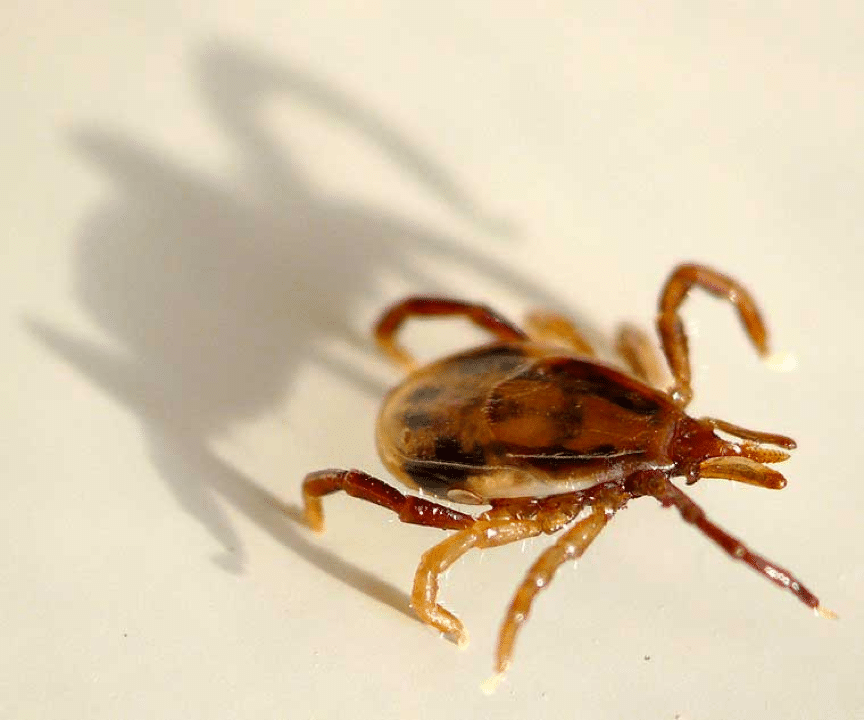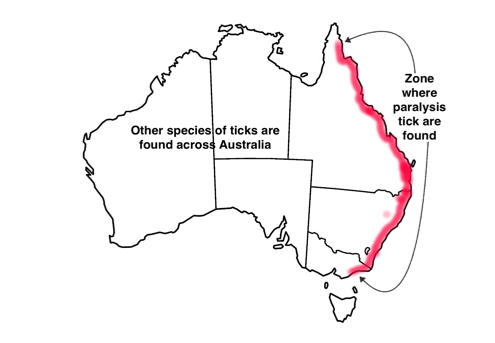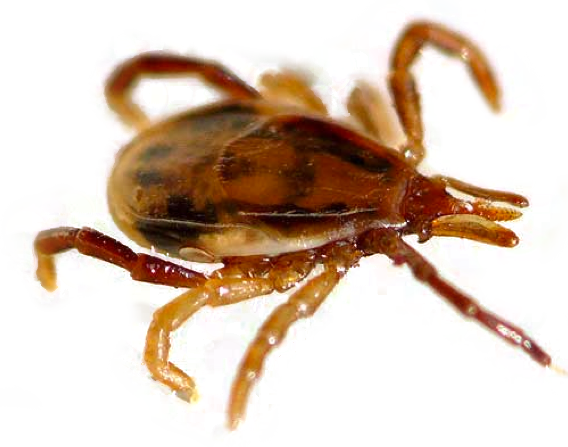Facts about ticks

What are they?
Ticks are arachnids (related to spiders and scorpions- adults ticks have 8 legs). They are parasites, specifically “ectoparasites” which means they live on the skin of hosts. Ticks must feed on the blood of animals to survive, grow and reproduce.
Life cycle
Ticks go through 4 life stages:
- Egg
- Larva or seed ticks (tiny dots of 0.5mm)
- Nymph (bigger dots of 1mm)
- Adult (from about 4mm to 10mm when engorged)
Ticks must get a blood feed to progress from larva to nymph; then nymph to adult. An adult female needs another blood meal before she can lay a clutch of eggs. Ticks are not fussy about what creatures provide the blood. They will feed from all mammals, birds and reptiles.

Where are they?
In Australia there are more than 70 species of ticks. The nastiest is the paralysis tick, Ixodes holocyclus. It inhabits the eastern coast of Australia and a band 20 or 30 km inland, from around Cape Conran in Victoria in the south to Cooktown in Queensland in the north. Some places (such as the northern beaches of Sydney) are notorious hotspots for Ixodes holocyclus. The distribution is changing and occurrence of Ixodes holocyclus has been reported from central Victoria and Melbourne suburbs.
More facts
What happens when a tick bites?



What happens when a tick bites? (more information)
Why are ticks so toxic?
Some of the nastier consequences of a tick bite include:
- severe life threatening allergic reactions to the tick bite in susceptible people
- development of an allergic response to consumption of mammalian meat (and other food products such as milk and gelatine sourced from mammals)
- infection with debilitating microbial diseases such as scrub typhus, (caused by Rickettsias), encephalitis (caused by viruses), and parasites
- paralysis and death if not removed safely and promptly (this is rare for people – but sadly not for cats and dogs).
What can you do to avoid ALL THIS?
1. Avoid going into areas where nasty paralysis ticks live. Sadly, the Australian paralysis ticks (Ixodes holocyclus) love the humid warm conditions that occur all along the east coast and a bit inland. Most Australians live, work and play in this zone. 2. Do all you can to prevent ticks getting onto your skin
- They don’t drop from the trees! (take a look at Tick Myths). They get aboard from low vegetation and then crawl up.
- Use insect repellent – and do spray your feet ankles and legs.
- Wear light coloured clothes, tuck trousers into your socks
- Keep lawns mown and shrubs away from paths.
- Conduct tick checks – especially children and pets.
if you get a tick bite
NEVER EVER EVER
- scratch the tick out
- pull it out with blunt tweezers and risk squashing it and squeezing in some of the toxic load in the tick
- dab it with chemical (insecticide or petrol or something that granddad recommends). See here for how quickly ticks are killed with Tick Tox compared to some of the silly ways people still try and kill ticks.
- smother with lanoline or vaseline or something oily
Every one of these will disturb the tick and can encourage it to spit its horrible load into you or your child or pet.
What do you do?
Get and apply Tick Tox®. Freeze your ticks off! Tick Tox ® snap freezes (and kills) ticks on humans and animals. A short burst of Tick Tox ® immediately kills ticks on humans and animals. There is NO disturbance to the nasty pest. It has no time to inject you with any more of its toxic load. It takes a few minutes for the (dead) tick to loosen its grip, as it has an impressive set of fish hooks on its jaws to prevent you from dislodging it. After a few minutes, you can brush the dead tick off and apply a dab of antiseptic to the bite site. Some dead ticks don’t let go easily – so spray some antiseptic onto the bite site and be patient.
